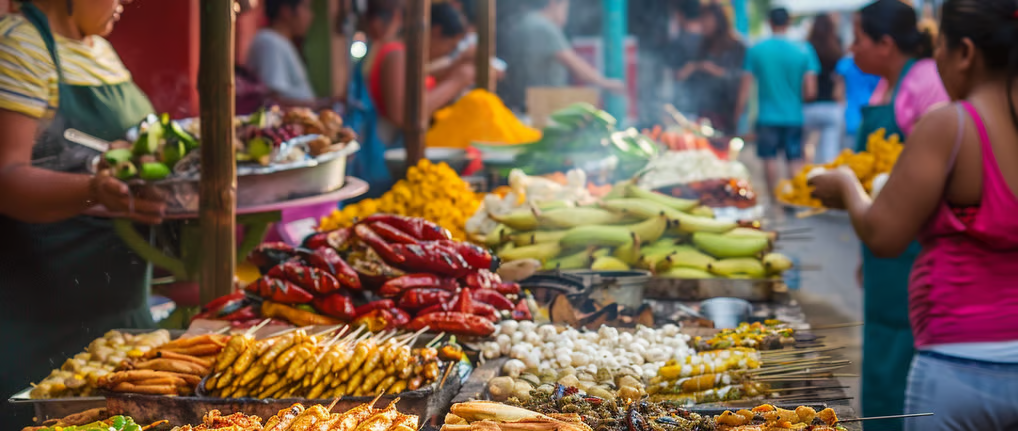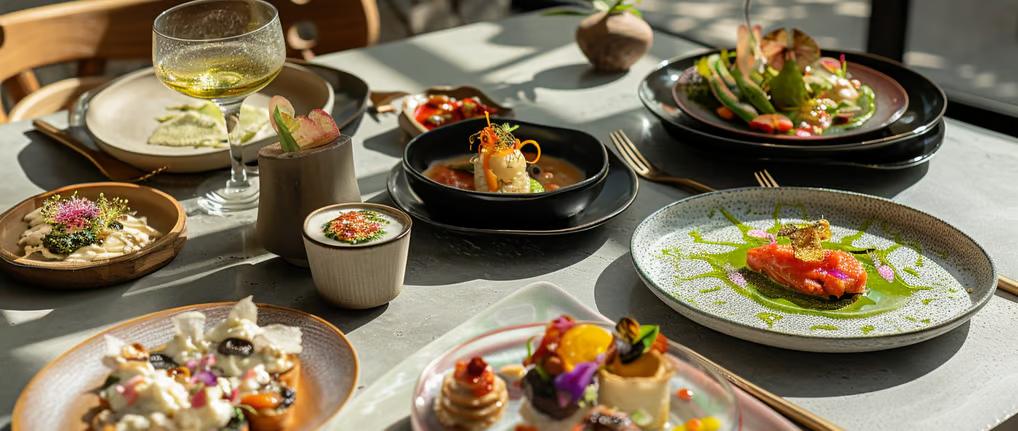A Culinary Tour of Mexico: From Street Tacos to Gourmet Delights
Embark on a flavorful journey across Mexico, where culinary adventures range from savoring the simplest street tacos to indulging in gourmet delights, each bite a testament to the country's diverse and rich gastronomic landscape.

Mexico is a country renowned for its incredible cuisine that tantalizes taste buds with a rich tapestry of flavors. From mouthwatering street tacos to exquisite gourmet creations, Mexican food offers an explosion of taste and a journey through history. Let's embark on a culinary tour of Mexico, exploring the diversity and cultural significance of its cuisine.
Exploring the Richness of Mexican Cuisine
When it comes to Mexican food, there is so much more than meets the eye. The historical roots of Mexican food can be traced back to the indigenous cultures that inhabited the region long before the arrival of the Spanish. These ancient civilizations, such as the Aztecs and Mayans, cultivated corn, beans, and chili peppers, which remain staple ingredients in Mexican cuisine to this day.
One of the remarkable aspects of Mexican cuisine is the incredible diversity of regional dishes. Each state in Mexico has its own take on traditional recipes, resulting in a wide range of flavors and culinary traditions. From the Yucatan Peninsula's pibil dishes to the spicy delights of Oaxaca and the seafood delicacies of Baja California, every region offers a unique culinary experience.
Let's delve deeper into the culinary wonders of Mexico. In the Yucatan Peninsula, for example, you will find the famous dish called Cochinita Pibil. This succulent slow-roasted pork is marinated in a blend of citrus juices, achiote paste, and spices, then wrapped in banana leaves and cooked in an underground pit. The result is tender, flavorful meat that melts in your mouth, accompanied by pickled onions and habanero salsa to add a tangy kick.
Heading over to Oaxaca, prepare your taste buds for a fiery adventure. Oaxacan cuisine is known for its bold and complex flavors, with dishes like Mole Negro stealing the spotlight. Mole Negro is a rich, dark sauce made from a blend of chili peppers, chocolate, nuts, and spices. It is traditionally served over tender chicken or turkey, creating a harmonious balance of smoky, spicy, and slightly sweet flavors that will leave you craving for more.
The Street Food Scene in Mexico
No culinary exploration of Mexico would be complete without diving into the vibrant street food scene. At the heart of Mexican street food is the ubiquitous taco, a versatile and beloved dish that comes in countless variations. From the savory al pastor tacos to the tangy fish tacos of Baja California, each taco tells a story.
But Mexican street food goes beyond tacos. The bustling markets and food stalls offer an array of other street food staples. Sink your teeth into a piping hot elote, a charred corn cob slathered in chili powder and lime juice, or indulge in the crispy and flavorful churros that melt in your mouth.
As you wander through the streets of Mexico, you'll be greeted by the enticing aroma of sizzling meats and spices. Follow your nose to the tantalizing scent of carne asada, a juicy and tender grilled beef that is marinated in a flavorful blend of citrus juices, garlic, and spices. The sizzle of the meat on the grill and the sound of the vendor chopping it up adds to the sensory experience of enjoying this classic Mexican street food.
And let's not forget about the mouthwatering tamales, a traditional Mexican dish made of masa dough filled with a variety of savory or sweet fillings. These little parcels of goodness are wrapped in corn husks and steamed to perfection. Whether you prefer the savory tamales filled with tender shredded chicken and smothered in a rich mole sauce, or the sweet tamales filled with cinnamon-spiced raisins and topped with a drizzle of creamy caramel sauce, you'll find yourself craving these delectable treats long after you've left Mexico.

The Rise of Gourmet Mexican Cuisine
In recent years, Mexico has witnessed a culinary renaissance with the rise of gourmet Mexican cuisine. Influential chefs have elevated traditional recipes to new heights, creating innovative and tantalizing dishes that fuse Mexican flavors with international culinary techniques. World-renowned restaurants like Pujol in Mexico City and Quintonil in Playa del Carmen showcase the creativity and ingenuity of Mexican gastronomy.
These talented chefs have reintroduced forgotten ingredients and cooking methods, breathing new life into traditional dishes. They blend indigenous flavors with global influences, resulting in an explosion of taste and textures on the plate. Dining at these establishments is not just a meal; it's a multisensory journey through the flavors of Mexico.
One example of this culinary renaissance is the reinvention of the humble taco. Traditionally, tacos were simple street food, consisting of a tortilla filled with meat, salsa, and maybe some onions and cilantro. However, gourmet Mexican chefs have taken this humble dish and transformed it into a work of art. They experiment with different types of tortillas, from corn to blue corn to hibiscus-infused tortillas, each adding its own unique flavor and color to the taco. The fillings have also become more elaborate, with options like slow-cooked pork belly, grilled octopus, or even vegetarian alternatives like roasted cauliflower.
Furthermore, the toppings and garnishes have become a crucial part of the gourmet taco experience. Chefs meticulously select the perfect combination of fresh herbs, pickled vegetables, and artisanal salsas to complement the flavors of the filling. The result is a symphony of flavors and textures, with each bite offering a different sensation.
The Role of Local Ingredients in Mexican Cuisine
One of the defining characteristics of Mexican cuisine is its reliance on local ingredients. The use of indigenous ingredients is deeply rooted in the cultural heritage of Mexico. From the vibrant red hues of prickly pear cactus to the earthy flavor of huitlacoche, an edible fungus that grows on corn, these ingredients add depth and complexity to dishes.
The impact of climate and geography on Mexican cuisine cannot be underestimated. Coastal regions boast an abundance of fresh seafood, while the fertile soils of the Central Valley yield an array of fruits and vegetables. The arid desert regions, like the Sonoran Desert, produce unique and hardy ingredients that have become an integral part of the local cuisine.
Let's delve deeper into the fascinating world of Mexican ingredients. Take, for example, the vibrant red hues of the prickly pear cactus, also known as nopal. This versatile ingredient not only adds a pop of color to dishes but also offers a range of health benefits. Rich in fiber, vitamins, and antioxidants, nopal has been used for centuries in Mexican cuisine for its medicinal properties. Whether grilled, sautéed, or added to salads, nopal brings a unique flavor and texture to any dish.
Another intriguing ingredient is huitlacoche, also known as the "Mexican truffle." This edible fungus grows on corn and is highly prized for its earthy and smoky flavor. Huitlacoche has a long history in Mexican cuisine, with indigenous communities considering it a delicacy. Its unique taste and velvety texture make it a sought-after ingredient in dishes like quesadillas, tamales, and soups.
Now, let's explore the impact of climate and geography on Mexican cuisine. The coastal regions of Mexico, such as Baja California and Veracruz, offer a bountiful selection of fresh seafood. From succulent shrimp to flavorful fish like red snapper and grouper, these coastal treasures are often the star of dishes like ceviche, seafood cocktails, and fish tacos. The proximity to the ocean ensures that Mexicans have access to an abundance of high-quality seafood, which greatly influences their culinary traditions.
In contrast, the Central Valley of Mexico is known for its fertile soils, which yield an impressive variety of fruits and vegetables. From juicy tomatoes and sweet mangoes to vibrant chilies and aromatic herbs like cilantro and epazote, the Central Valley provides the foundation for many traditional Mexican dishes. The combination of rich soil, ample sunlight, and a temperate climate creates the perfect conditions for these ingredients to thrive, resulting in flavors that are unparalleled in their freshness and intensity.
Lastly, let's not forget the arid desert regions of Mexico, such as the Sonoran Desert. Despite the harsh conditions, these regions have given rise to unique and hardy ingredients that have become an integral part of Mexican cuisine. The nopal cactus, for example, thrives in these arid landscapes and has been a staple in Mexican diets for centuries. Its ability to withstand extreme temperatures and scarcity of water makes it a resilient and valuable ingredient. Additionally, the desert regions are home to a variety of wild herbs and plants, like the piquant epazote and the aromatic hoja santa, which add distinctive flavors to traditional dishes.

The Cultural Significance of Food in Mexico
In Mexico, food is not just sustenance; it is a social bond that brings people together. Sharing a meal is a cornerstone of Mexican culture, strengthening ties and fostering community. From Sunday family gatherings to festive celebrations, food plays a central role in Mexican traditions.
Throughout the year, Mexico hosts numerous festivals and celebrations centered around food. From the iconic Day of the Dead to regional events like the Guelaguetza in Oaxaca, these festivities showcase the diversity and vibrancy of Mexican cuisine. It's during these gatherings that generations-old recipes are passed down, ensuring that culinary traditions remain alive and cherished.
Savor The Best of Mexican Flavors
Embarking on a culinary tour of Mexico is a sensory adventure that will ignite your taste buds and open your eyes to the culture and traditions of this vibrant country. From the bustling streets of Mexico City to the tranquil beaches of the Riviera Maya, every region offers a unique gastronomic experience.
So why not plan your own culinary journey through Mexico? Explore the local markets, indulge in delicious street food, and dine at esteemed restaurants that showcase the best of Mexican cuisine. Whether you're an adventurous foodie or simply appreciate good food, Mexico is sure to delight your palate and leave you craving for more.